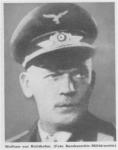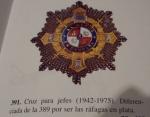
Panzerpionier
Active Contributor-
Posts
127 -
Joined
-
Last visited
Content Type
Profiles
Forums
Blogs
Gallery
Events
Store
Everything posted by Panzerpionier
-
Please note that I am not actually writing a book... it was just a (silly) example...
-
I want to add add that using the German name of a Spanish decoration on a book written in English (Milit?rmedaille) makes no sense. Think about this: I write a book in English about the Spanish Blue Squadrons in the Eastern Front... which paragrapgh sounds better? (a) Spanish pilots were awarded the German Operational Flying Clasp in Silver (Broche por Vuelos Operacionales en Plata) (b) Spanish pilots were awarded the German Operational Flying Clasp in Silver (Frontflugspange im Silber). © Spanish pilots were awarded the German Operational Flying Clasp in Silver (Frontflugspange im Silber, known as Broche por Vuelos Operacionales en Plata by the Spanish personnel). My vote goes for (b), but of course © is even better.
-
I simply copied and pasted from an older post dating back to Aug 4th, 2005: http://gmic.co.uk/index.php?showtopic=1315 Post #13 -First of all, the Medalla Militar (Military Medal) was the third Spanish award, not the second one according to 1938 Nationalist regulations. The highest award was the Ascenso por M?ritos de Guerra (promotion due to war merits), followed by the Cruz Laureada de San Fernando (Laureated Cross of Saint Ferdinand). -The Military Medal was a very coveted and scarce award. They were awarded either for single acts of extraordinary bravery (usually posthumously) or for outstanding service in a specific campaign. In the former case the medal was usually awarded few weeks or months after the date of the action, but in the later case it took years or even decades to be awarded, because the merits of the potential recipient were checked thoroughly and the process took a lot of time (perhaps the astonishing slowness of Spanish bureaucracy is a better explanation!). -Spanish recipients had their Military Medals custom made by renowned jewelers, usually in silver with studded diamonds. Sometimes the medals were presented to the recipients by their comrades or subordinates and usually engraved with the name of the recipient and/or the place and date of the action. -Most of the medals awarded to German soldiers were mass-produced by renowned manufacturer Industrias Ega?a and conferred prior to the departure of the Legion. Commanders of the Legion (Sperrle, Volkmann, Richthoffen) received custom/deluxe medals with studded diamonds. On the other hand, Martin Harlinghausen's medal seems to be made of silver but without diamonds - it looks Spanish-made to me, so perhaps very distinguished officers received medals that were better than those mass-produced but cheaper than those of the "big bosses". -As stated before, the Military Medal was a very coveted and scarce award, and it was intended to be worn always as a complete medal, not as a ribbon. It seems that Germans were not properly informed about the wearing and importance of the award. Otherwise they would had not worn them in a ribbon bar with the usual crossed swords (not included in Spanish regulations). Think about this: an non-German Axis soldier awarded with the Knight's Cross wearing a tiny Iron Cross ribbon with crossed swords instead of the complete KC. It does not make sense, right?... Well, German soldiers actually did exactly that with their Military Medals... -There is a list of 60 German recipients of the Military Medal LC members in a Spanish book, but it seems that many more were awarded. In most cases they were awarded at the end of the war to unit commanders and distinguished officers and NCO's, but a few were awarded posthumously after single or repeated acts of bravery during the war (i.e. Hans-Detlef von Kessel, Hannibald von Moerner). It seems also that the proportion of German recipients of the Military Medal was much higher than that of the Spanish recipients, and of course German soldiers did not have to wait for years to receive their medals. In my opinion, those facts together with the wrong way of wear depreciated their medals somehow. That is my humble knowledge about the subject. Best regards
-
Never mind. Sorry if I was rude. Please refer to the new thread opened by Jacques for my opinion on the subject. Best regards
-
Please post a scan of the original Spanish regulations that established that medal. I will be happy to be educated about the decorations of my own country by a foreigner. Best regards
-
There was no decoration with that name...
-
You can find one on p. 109 of Bender's book. It seems that Richthofen changed the visor cap for his overseas cap when they arrived to Hamburg. Best regards
-
Note that the pic of Richthofen with peaked cap has been retouched from a LW pic. Richthofen used a peaked cap in the return trip to Germany, but the design was different than those of Sperrle and Volkmann. Best regards
-
Jacques, is the sunburst of the bottom cross matte grey or bright silver? If it is bright silver, your medal is probably a 1942 cross for senior oficers (majors, Lt. colonels and colonels). 1942 crosses for generals had a golden sunburst, and junior officers received crosses with bronze sunburst. NCO's and enlisted men received a different cross hanging from a ribbon. Sorry for the bad picture but I have no scanner. Best regards
-
The War Cross awarded to LC members was a SCW-only award. After the war the medal was split into different classes and the original design was changed. Best regards
-
http://www.wehrmacht-awards.com/forums/sho...ghlight=rokiski http://www.wehrmacht-awards.com/forums/sho...ghlight=rokiski
-
Please note that I wrote that I believe it is probably a modern assembly with original parts. That is my gut feeling. If I was absolutely sure, I would have used different words. I have not handled the medal bar and I am not an expert in WWII era construction techniques, but I think Medals for Suffering awarded to Germans were simply too scarce and now they seem to be very common. For that reason I don't like German ribbons with that medal. But as I wrote before, it is just a gut feeling and not a product of logic. If you are happy with your medal, then is your opinion against my gut feeling. I can not find any additional evidence against your medal bar. Best regards
-
The Spanish Foreign Legion used a very similar hat called "Chambergo" during the Spanish campaigns in Morocco: http://www.lalegion.com/tradiciones/unifor...uniformidad.htm Best regards
-
Hi my friend I never said Medals for Sufferings were not awarded to LC members. I believe that both enameled and enlisted men medals were actually awarded. I meant that probably those ribbon bars (I would say Schudziak's medal bar too) are modern assemblies with original parts. Best regards
-
C'mon guys! We are talking about a medal that was unknown three years ago! In 2002 my friend Francisco V. asked me about a strange medal that was for sale at Weitze's. Finally Bill Stump bought that medal and posts started to cross in Wehrmacht-awards and Germanuniforms forum. I am sure you never saw that medal before. http://www.wehrmacht-awards.com/forums/sho...light=suffering Today shiny, brand new LC ribbon bars with Medals for Suffering are springing up everywhere. Very strange for an almost unknown medal that was awarded to about 200 German recipients only... Just my 2 cents. Best regards
-
Hello to everybody. I am new here, but we have met before at WH-awards forum. I hope we will learn together about the German intervention in the SCW. I would like to make some comments about Jacques' words: -First of all, the Medalla Militar (Military Medal) was the third Spanish award, not the second one according to 1938 Nationalist regulations. The highest award was the Ascenso por M?ritos de Guerra (promotion due to war merits), followed by the Cruz Laureada de San Fernando (Laureated Cross of Saint Ferdinand). -The Military Medal was a very coveted and scarce award. They were awarded either for single acts of extraordinary bravery (usually posthumously) or for outstanding service in a specific campaign. In the former case the medal was usually awarded few weeks or months after the date of the action, but in the later case it took years or even decades to be awarded, because the merits of the potential recipient were checked thoroughly and the process took a lot of time (perhaps the astonishing slowness of Spanish bureaucracy is a better explanation!). -Spanish recipients had their Military Medals custom made by renowned jewelers, usually in silver with studded diamonds. Sometimes the medals were presented to the recipients by their comrades or subordinates and usually engraved with the name of the recipient and/or the place and date of the action. -Most of the medals awarded to German soldiers were mass-produced by renowned manufacturer Industrias Ega?a and conferred prior to the departure of the Legion. Commanders of the Legion (Sperrle, Volkmann, Richthoffen) received custom/deluxe medals with studded diamonds. On the other hand, Martin Harlinghausen's medal seems to be made of silver but without diamonds - it looks Spanish-made to me, so perhaps very distinguished officers received medals that were better than those mass-produced but cheaper than those of the "big bosses". -As stated before, the Military Medal was a very coveted and scarce award, and it was intended to be worn always as a complete medal, not as a ribbon. It seems that Germans were not properly informed about the wearing and importance of the award. Otherwise they would had not worn them in a ribbon bar with the usual crossed swords (not included in Spanish regulations). Think about this: an non-German Axis soldier awarded with the Knight's Cross wearing a tiny Iron Cross ribbon with crossed swords instead of the complete KC. It does not make sense, right?... Well, German soldiers actually did exactly that with their Military Medals... -There is a list of 60 German recipients of the Military Medal LC members in a Spanish book, but it seems that many more were awarded. In most cases they were awarded at the end of the war to unit commanders and distinguished officers and NCO's, but a few were awarded posthumously after single or repeated acts of bravery during the war (i.e. Hans-Detlef von Kessel, Hannibald von Moerner). It seems also that the proportion of German recipients of the Military Medal was much higher than that of the Spanish recipients, and of course German soldiers did not have to wait for years to receive their medals. In my opinion, those facts together with the wrong way of wear depreciated their medals somehow. Best regards



